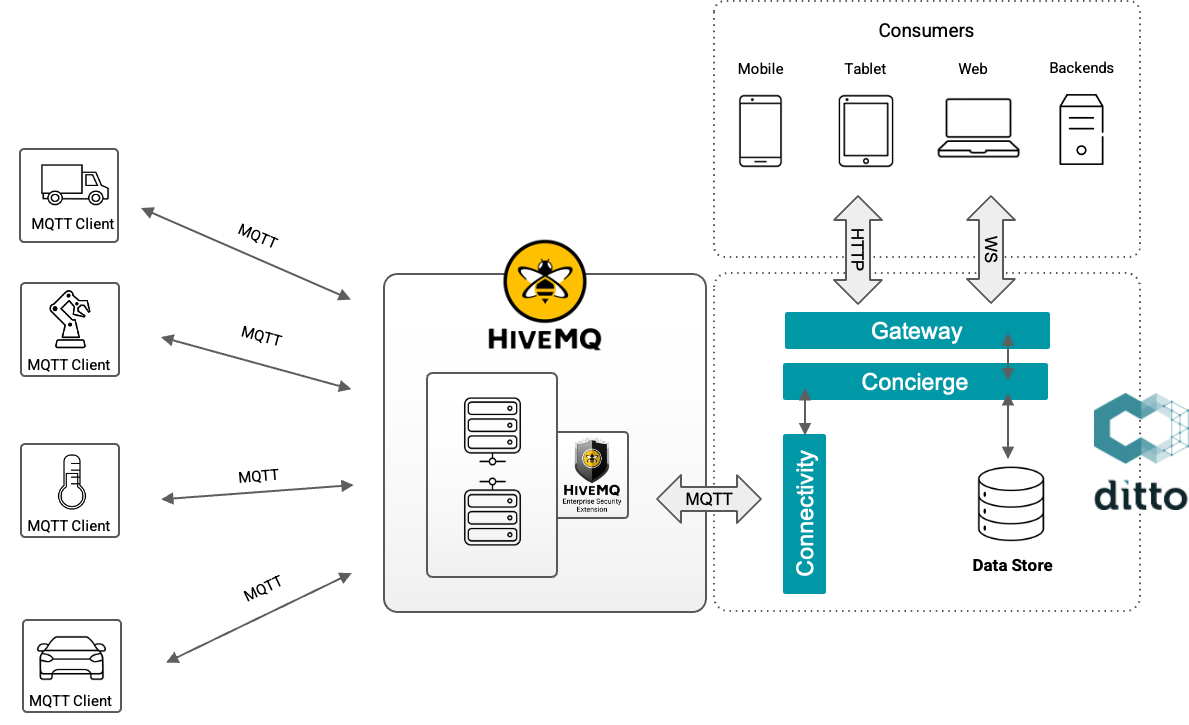HiveMQ and Eclipse Ditto: Friends or Foes?
When it comes to connecting the world of objects to the digital world, several approaches are possible. It is possible to interact directly with connected objects via protocols such as MQTT and a broker like HiveMQ, or to use a layer of abstraction in developments, taking advantage of the Digital Twins concept. Digital Twins enables you to benefit from a representation of the latest state of the various information sent by your connected objects. An open-source solution called Eclipse Ditto stands out from the crowd, combining the flexibility and power of the MQTT protocol with Digital Twins representation of data from different objects via APIs that can be consumed from your business applications and/or mobile applications.
Let’s stop for a minute to define some vocabulary
A digital twin is a virtual representation of a physical object, system, or process. It's created by collecting and integrating data from sensors, simulations, and other sources to mirror the real-world counterpart in a digital environment. This allows for monitoring, analysis, and simulation to improve understanding, performance, and decision-making related to the physical entity. Digital twins are commonly used in various fields, including manufacturing, healthcare, urban planning, and more.
MQTT (Message Queuing Telemetry Transport) is a lightweight and efficient messaging protocol designed for reliable communication between devices or applications in a publish-subscribe or client-server model. It is particularly well-suited for the Internet of Things (IoT) and other resource-constrained environments. MQTT uses a "broker" to facilitate message exchange, where clients (devices or applications) can publish messages to specific topics and subscribe to receive messages from those topics. It's known for its simplicity, low overhead, and ability to handle intermittent network connections, making it a popular choice for IoT and other real-time communication scenarios.
What is Eclipse Ditto?
Eclipse Ditto is an open-source project that serves as an infrastructure for managing digital twins and device data in the context of the Internet of Things (IoT). It provides a platform for creating and managing digital representations (digital twins) of physical devices or assets. These digital twins can store information about device status, configuration, and other relevant data, enabling efficient monitoring, control, and communication with IoT devices. Eclipse Ditto simplifies IoT application development and data management by offering standardized APIs and protocols for interacting with digital twins, making it easier to build IoT solutions that require device management and real-time data processing.
What Makes Eclipse Ditto Unique?
Eclipse Ditto offers several unique features and advantages in the context of IoT and digital twin management:
Open Source: Eclipse Ditto is an open-source project, making it accessible for a wide range of organizations and developers. It benefits from contributions and feedback from a global community.
Digital Twins: Eclipse Ditto specializes in digital twin management, allowing you to create virtual representations of physical devices or assets. This feature is central to IoT applications for monitoring and controlling real-world objects.
Standardized APIs: It provides standardized APIs for managing digital twins, which simplifies the development of IoT applications and ensures interoperability between devices and applications.
Scalability: Eclipse Ditto is designed to scale horizontally, making it suitable for managing a large number of devices and their digital twins in enterprise and industrial IoT scenarios.
Data Model: It offers a flexible data model that allows you to define custom attributes and properties for digital twins, accommodating a wide range of IoT devices with varying capabilities and requirements.
Protocol Agnostic: While MQTT is commonly used in conjunction with Eclipse Ditto, it is not limited to MQTT. It can work with different communication protocols, enabling flexibility in device connectivity.
Security: It includes robust security features for ensuring the confidentiality, integrity, and authenticity of data and device interactions, critical in IoT deployments.
Real-time Data Processing: Eclipse Ditto can process and manage real-time data, which is essential for IoT applications that require up-to-the-minute information from devices.
Rules and Notifications: It supports the creation of rules and notifications to automate actions and alerts based on changes in device data, enhancing the efficiency of IoT operations.
Historical Data: It stores historical data from devices, allowing for analysis, trend detection, and performance monitoring over time.
Device Lifecycle Management: Eclipse Ditto helps manage the entire device lifecycle, from onboarding and configuration to monitoring and eventual decommissioning.
Multi-Tenant Support: It supports multi-tenancy, enabling different organizations or users to share the same infrastructure while keeping their data and configurations separate and secure.
Community and Ecosystem: Being an Eclipse project, Ditto benefits from the Eclipse Software Foundation's vast ecosystem and a supportive community of developers and users.
These unique features make Eclipse Ditto a powerful and versatile solution for managing digital twins and IoT devices in a wide range of applications, from smart cities to industrial automation and beyond.
How HiveMQ and Eclipse Ditto Work Together

Eclipse Ditto and HiveMQ can work together to facilitate communication and data management in IoT and digital twin applications. Here's how they can be integrated:
HiveMQ for Real-time Data Exchange:
HiveMQ and MQTT are used for efficient, real-time data exchange between IoT devices and a central MQTT broker.
IoT devices can publish data to MQTT topics, and subscribers (which could be Eclipse Ditto or other applications) can receive these updates.
The Enterprise Security extension offers the first level of security for managing device connections and data transfers.
Eclipse Ditto for Digital Twin Management:
Eclipse Ditto can create and manage digital twins for IoT devices. Each digital twin represents a virtual, real-time mirror of a physical device.
These digital twins store device information, status, configurations, and historical data.
Integration Points:
When an IoT device publishes data via HiveMQ Broker, Eclipse Ditto can subscribe to relevant MQTT topics to capture the incoming data.
Eclipse Ditto can update the digital twin's state with the received data, keeping the digital twin in sync with the physical device.
Decoupling and Abstraction:
This integration decouples the real-time data exchange (MQTT) from the digital twin management (Eclipse Ditto).
It abstracts the complexities of device management and data handling from the IoT applications.
Enhanced Application Development:
Developers can build applications that interact with the digital twins in Eclipse Ditto to monitor device status, configure devices, and perform actions based on real-time data.
This integration simplifies the development of IoT applications by providing a standardized and well-structured way to manage devices and their data.
In a nutshell, Eclipse Ditto and HiveMQ can complement each other, with HiveMQ as the central broker handling real-time data exchange from IoT devices, while Eclipse Ditto manages digital twins and provides a unified interface for applications to interact with IoT devices. This combination is valuable for building scalable and efficient IoT solutions.

Anthony Olazabal
Anthony is part of the Solutions Engineering team at HiveMQ. He is a technology enthusiast with many years of experience working in infrastructures and development around Azure cloud architectures. His expertise extends to development, cloud technologies, and a keen interest in IaaS, PaaS, and SaaS services with a keen interest in writing about MQTT and IoT.
